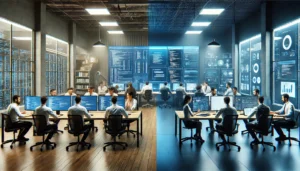Integration and interoperability are crucial concepts in this new world of tool stacks. We use many different technologies in our daily working lives, and to truly gain from them, we must connect other platforms and systems into a seamless (or nearly seamless) architecture. This issue has never been more pressing than when considering content management.
What Does CMS Interoperability Mean for Web Development?
When your business can integrate content management systems like WordPress with other tools, software, and systems, you can start to create a comprehensive and efficient digital ecosystem. This integration has several sizable benefits.
For a start, it leads to an enhanced user experience. When you achieve interoperability in software architecture, users experience higher functionality and a more cohesive journey as they navigate the different arenas of your world. This impacts social media engagement, on-site actions, and more.
You’ll also see increased efficiency in your web development and maintenance activities. For example, WordPress API integration — integration with databases and third-party services — means developers can leverage existing solutions rather than building features from scratch. Maintenance becomes more manageable when systems communicate smoothly to organize updates, data synchronization, and troubleshooting.
Thirdly, CMS interoperability is crucial to the scalability and futureproofing of your site. A WordPress site designed with interoperability in mind can adapt to modern technologies and trends without requiring extensive overhauls, allowing your team to enjoy gradual and sustainable growth.
The Key Elements (and Challenges) of WordPress Integration
WordPress may be the obvious choice when setting up a scalable CMS architecture. If you decide to integrate WordPress, consider a few key elements:
• API Compatibility. Compatibility issues can plague teams as they build their web architecture, with systems often using incompatible technologies and data formats. Instead of finding yourself in this dilemma, use middleware or integration tools to translate data. Set up WordPress API integration, for instance, with your other external systems by using the REST API, which ensures effective communication between data formats and protocols.
• Security and data protection. The interoperability of a website is also critical to its security. Introducing new elements or external systems could open new vulnerabilities in your architecture, so you will want to implement strong security measures, such as secure API endpoints and data encryption, and regularly update WordPress components, like plug-ins and themes, to safeguard your organization and your users.
• Performance optimization. Integrations can sometimes slow down website speed and performance due to added server requests and data processing, so optimizing integration processes before they slow you down is wise. Use caching strategically to reduce server load and consider asynchronous loading for noncritical integrations to improve the user experience.
• Data management. Keeping data synchronized between WordPress and external systems can be complex, especially in real-time applications. To ensure CMS interoperability, you will need robust data management protocols and APIs supporting real-time data exchange. You must also regularly monitor data flows to guarantee accuracy, compatibility, and timeliness.
• Maintenance. Updating and running a scalable CMS architecture can be an ongoing challenge. That’s why the interoperability of a website depends on developers’ ability to maintain an environment of reviewing and testing. Review updates and integrations as they evolve and always before deploying them live to end users. Stay informed about updates from WordPress and other external systems, and establish an error-handling routine to avoid costly downtime.
• Scalability. Last but not least, scalability is likely the reason you’re even thinking about the interoperability of a website. Scalability can happen slowly or suddenly, in spits and spurts or all at once, and creating predictability as you build a scalable CMS architecture is a challenge. Design with scalability in mind, compensating for increases and dips in traffic and baking flexibility into how you use new technologies and platforms.
How to Achieve Interoperability in Software Architecture in 4 Steps
Ndevr knows the challenges of building interoperability inside out. Our expertise and diverse experience can help you face these challenges.
1. Integrate for the end user.
The dream of a well-integrated site is a flowing, exciting user experience. Interoperability directly integrates various services and platforms, such as social media, e-commerce, and customer relationship management systems, into the WordPress site. This seamless integration leads to a more cohesive and enjoyable user experience. Users can also experience a more consistent interface across different devices and platforms, which is necessary for maintaining engagement and satisfaction.
2. Find your own solutions.
The remarkable thing about interoperable WordPress sites is that they offer administrators the flexibility to customize and extend their websites’ functionality by integrating a variety of plug-ins, tools, and external applications. Make the most of this opportunity by dreaming up your desired custom options. As the needs of your website grow, the Ndevr team can develop tailored integration solutions that align with your shifting goals, helping you integrate with new technologies and scale up efficiently without considerable overhauls.
3. Connect maintenance and performance.
Performance and maintenance are intricately connected. With a commitment to ongoing support and maintenance, Ndevr can continuously monitor and update integration systems, ensuring they remain effective and efficient over time. At the same time, we have a head for performance optimization. We implement tactics and tools like caching and asynchronous loading to optimize and maintain fast and responsive websites, even with complex, custom integrations.
4. Empower your team.
Training and empowerment are vital but often overlooked pieces of the interoperability puzzle. One of the end goals of developing a CMS architecture is so that all your team members can communicate and manage their workflows more synchronously. Beyond providing solutions, Ndevr can empower clients through training and knowledge transfer. This approach enables clients to understand and manage their integrated systems more effectively, fostering a sense of ownership and control over their digital assets.
By building interoperability in these ways, you can ensure that your websites are integrated, functional, secure, scalable, and aligned with your long-term business objectives.





